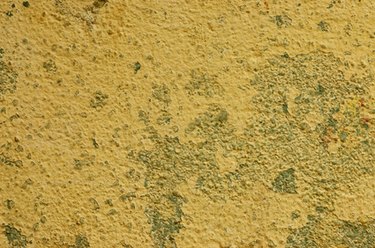Things You'll Need
Cloth
Soap
Water
Wet/dry sandpaper
Squeegee
Spray lacquer
Polishing compound
Electric buffer

"Orange peel" is a condition that occurs when freshly applied paint doesn't completely level out. It's particularly a problem when you are spraying fast-drying finishes, such as lacquer or acrylic enamel. It can be a result of holding the gun too far away from the surface, allowing the solvent to evaporate before the paint has leveled. It can also happen if there is wax, silicone, or some other slippery material on the surface which causes the paint to bead. You can usually correct orange peel by buffing or applying another coat, but first you have to sand it down.
Step 1
Clean the surface with a cloth dampened with a soap solution or water to remove dust particles and overspray.
Video of the Day
Step 2
Give the surface a light once-over with fine sandpaper, sanding in a straight back-and-forth motion. If the surface is wood, use 400-grit paper. If it's metal, use 800 to 1,000-grit, depending on the condition of the orange peel. This light sanding will knock down the rough spots on the finish. Wipe it again with a damp cloth.
Step 3
Wet a sheet of wet or dry sandpaper of the next finest grade and sand again, moving the paper back and forth on the surface, not in a circular motion. If you are sanding wood, sand with the grain. Keep the surface well lubricated with water and change the paper whenever it begins to gum up. You will encounter some resistance when you begin, but as the surface begins to flatten out, you will feel the paper begin to glide over it.
Step 4
Lift the paper and rinse the surface periodically, then squeegee off the water and inspect your progress. When the surface develops a dull, flat appearance, it is properly sanded. If it is shiny, it needs more work.
Step 5
Wipe the surface when you have finished and let it dry. If you are finishing a wooden surface with lacquer, spray on another wet coat. If you are painting a metal surface with acrylic enamel or urethane, spread rubbing compound with a rag and buff the finish with an electric buffer.
Tip
Orange peel can develop with latex and alkyd paints, but because the surfaces these paints are used for are larger and rougher, it is not usually noticeable. You can sand alkyd paint to remove orange peel if desired.
Warning
Don't concentrate on sanding any one area for an extended period, especially with coarser paper, or you may sand through the finish.
Video of the Day